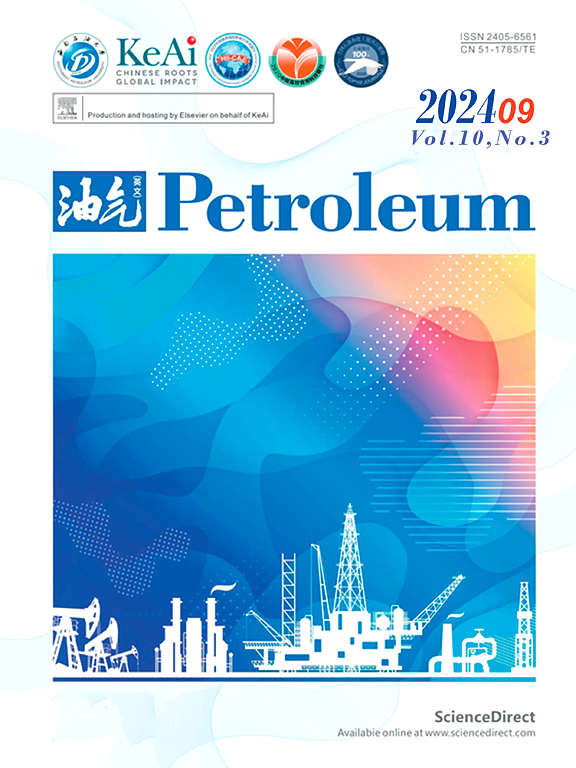碳酸盐岩基质酸化过程中酸岩相互作用及裂缝影响研究
IF 3.5
Q2 ENERGY & FUELS
引用次数: 0
摘要
本研究旨在通过基质酸化评价化学溶蚀作用对储层物性的影响,采用含裂缝和不含裂缝的合成碳酸盐岩,用石灰石粉、环氧树脂(化学惰性)制备,裂缝以垂直于流体流动方向的无纺布土工布条为代表,考察其对溶蚀作用的影响。采用恒压乙酸和蒸馏水溶液,开发了一套酸化测试系统,在36、72和108小时的接触时间内,观察有机酸与岩石的相互作用。进行了化学和岩石物理测试,并使用x射线显微计算机断层扫描进行了图像分析,以表征酸化效果。随着接触时间的增加,观察到岩石性质的变化,特别是孔隙度和渗透率的增加。观察了方解石与酸溶液反应生成的CO2和乙酸钙。虫孔呈分枝状,溶解模式均匀;此外,裂缝影响了其插入区域的溶解,增加了沿其结构存在的分支,并使流体流向与注入方向垂直的方向,特别是在72 h时观察到的,突出了土工布作为一种材料在合成样品中复制裂缝的透射率。所使用的方法有助于展示矿物溶解对增产后储层岩石性质的影响,强调化学/岩石物理方面的重要性,以及裂缝的作用,以便更好地了解现场基质酸化效率。本文章由计算机程序翻译,如有差异,请以英文原文为准。
Acid-rock interaction investigation and the influence of fractures during matrix acidizing in carbonate rocks
This study aimed to evaluate the effects of chemical dissolution on the properties of reservoirs by matrix acidizing, using synthetic carbonate rocks with and without fractures, prepared with limestone powder, epoxy resin (chemically inert) and fractures represented by non-woven geotextile strips positioned perpendicular to the fluid flow direction, to check their influence on the dissolution process. A system was developed using an acid injection cell to carry out acidizing tests, applying a solution of acetic acid and distilled water at constant pressure, to observe the organic acid-rock interaction for contact times of 36, 72 and 108 h. Chemical and petrophysical tests, as well as image analyses using X-ray micro-computed tomography were conducted to characterize the acidizing effects. Changes in rock properties were observed as the contact time increased, particularly the increase in porosity and permeability. Was observed the formation of CO2 and calcium acetate as reaction products between calcite and acid solution. Ramified wormhole and uniform dissolution patterns were noted; moreover, fractures influenced the dissolution in regions where they were inserted, increasing the branches present along their structure and deviating the fluid flow to a perpendicular direction to the injection direction, especially observed at 72 h, highlighting the use of geotextile as a material that reproduces the fractures' transmissivity in synthetic samples. The methodologies used contributed to presenting the effects of mineral dissolution on the properties of reservoir rocks post-stimulation, emphasizing the importance of chemical/petrophysical aspects and the contribution of fractures to better understand the matrix acidizing efficiency in field.
求助全文
通过发布文献求助,成功后即可免费获取论文全文。
去求助
来源期刊

Petroleum
Earth and Planetary Sciences-Geology
CiteScore
9.20
自引率
0.00%
发文量
76
审稿时长
124 days
期刊介绍:
Examples of appropriate topical areas that will be considered include the following: 1.comprehensive research on oil and gas reservoir (reservoir geology): -geological basis of oil and gas reservoirs -reservoir geochemistry -reservoir formation mechanism -reservoir identification methods and techniques 2.kinetics of oil and gas basins and analyses of potential oil and gas resources: -fine description factors of hydrocarbon accumulation -mechanism analysis on recovery and dynamic accumulation process -relationship between accumulation factors and the accumulation process -analysis of oil and gas potential resource 3.theories and methods for complex reservoir geophysical prospecting: -geophysical basis of deep geologic structures and background of hydrocarbon occurrence -geophysical prediction of deep and complex reservoirs -physical test analyses and numerical simulations of reservoir rocks -anisotropic medium seismic imaging theory and new technology for multiwave seismic exploration -o theories and methods for reservoir fluid geophysical identification and prediction 4.theories, methods, technology, and design for complex reservoir development: -reservoir percolation theory and application technology -field development theories and methods -theory and technology for enhancing recovery efficiency 5.working liquid for oil and gas wells and reservoir protection technology: -working chemicals and mechanics for oil and gas wells -reservoir protection technology 6.new techniques and technologies for oil and gas drilling and production: -under-balanced drilling/gas drilling -special-track well drilling -cementing and completion of oil and gas wells -engineering safety applications for oil and gas wells -new technology of fracture acidizing
 求助内容:
求助内容: 应助结果提醒方式:
应助结果提醒方式:


